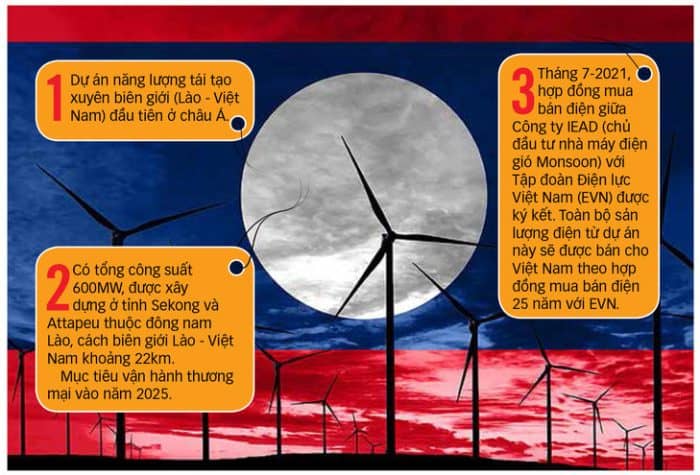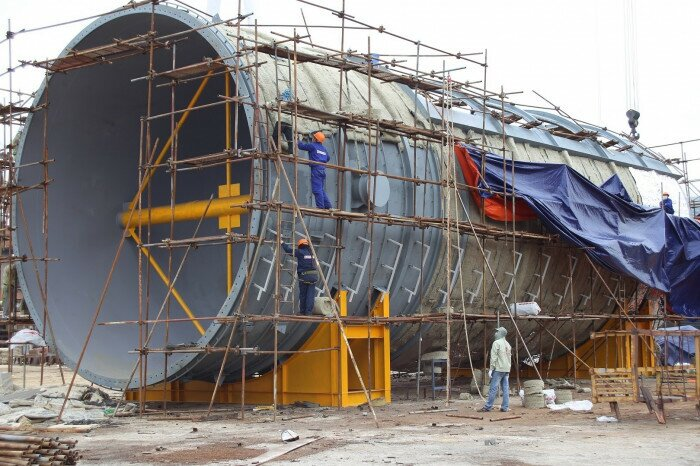The battery of Southeast Asia “towards wind power”
26/04/2023Laotians will probably never forget the disaster of a hydroelectric dam failure in Attapeu province in 2018. The major risks that could arise from reliance on hydropower have prompted the country to switch to wind power.

This week, Mitsubishi Group of Japan announced that under an agreement with the Asian Development Bank, it and other shareholders of the Laos monsoon project have raised $692 million to build wind farms. Japan International Cooperation Agency and other lenders (Reuters) This is not the only wind power project in this country.
Building large wind farms
The monsoon wind farm sector indicates that Laos, one of Asia’s largest exporters of hydroelectric power, is preparing to enter the wind power sector to avoid excessive reliance on depleted water resources.
According to the Nikkei Asia magazine, a monsoon wind farm is currently under construction in the sparsely populated mountainous areas of southeastern Laos and is expected to begin operation in 2025.
The project is expected to sell electricity to Vietnam under a 25-year contract, involving Mitsubishi Group (Japan), BCPG Renewable Energy Company (Bangchak, Thai Energy Group), and other companies.
The monsoon is located in Sekong and Attapeu provinces in southern Laos and will cover an area of 70000 hectares with 133 wind turbines upon completion. The 600-megawatt power generation capacity will make the monsoon one of the largest onshore wind farms in Southeast Asia.
It is worth noting that this is not the only wind power project implemented in Laos, as Laos has positioned itself as a “Southeast Asian battery” with an export-oriented energy policy. It is believed that at least 10 similar projects are in the planning stage across Laos.
About 80% of Laos’ electricity is sold to neighboring Thailand and Vietnam, accounting for 30% of its export value. Laos also began construction of transmission infrastructure in January this year and sold electricity to Cambodia.
Reduce dependence on hydropower
Currently, hydropower accounts for 70% of Laos’ total electricity generation. Although over 70% of Laos’ land is composed of mountains and plateaus, and many areas are suitable for building hydroelectric dams, concerns about hydropower dependence have prompted Laos to shift towards wind power generation.
Firstly, Laos’ hydropower production usually decreases during the dry season. Secondly, China’s control of the upstream rivers poses a risk of sudden changes in water levels, which poses a threat to agriculture and fisheries.
In 2018, a hydroelectric dam built by South Korean and Thai companies in the Atabe Province of southeastern Laos broke out, resulting in at least 71 deaths and over 6000 homeless.
Nowadays, wind power generation has become a promising option for Laos. In wind farms, turbines can work almost day and night, which is more efficient than solar panels.
According to Laos’ 2030 development plan, the Southeast Asian country hopes to maintain its current hydroelectric power generation rate and shift nearly 30% of its electricity generation from thermal power to renewable energy such as wind energy.
Due to the growing demand for renewable energy in neighboring countries, Laos has turned to a wind power investment strategy. Thailand’s goal is to achieve carbon neutrality by 2050. Vietnam has also set a goal of achieving net zero greenhouse gas emissions by 2050.
According to an industry insider quoted by Nikkei Asia, before the COVID-19 outbreak, Vietnam’s electricity demand was estimated to grow by 10% annually. According to some predictions, this demand will increase fivefold by 2050.
At present, some areas along the southern coast of Vietnam are suitable for developing wind power generation, but Vietnam’s self-produced power generation is not yet sufficient to meet domestic electricity demand.
Source: tuoitre.vn
Must Read
You may be interested in


Priority is given to investing in 29 seaport projects with a total capital of over 31 trillion Vietnamese Dong sourced from the state budget

Ba Ria – Vung Tau to become national marine economic hub

Improving the capacity of shipbuilding enterprises, catching the wave of opportunities

Completing negotiations and signing power purchase agreements with 40/40 transitional renewable energy investors

Vietnam expected to emerge as a prominent logistics player in Asia

Freight transportation from Ho Chi Minh City port to Barion Head port

Ho Chi Minh City orients to develop Can Gio “superport”

The maritime industry strives for green transformation








